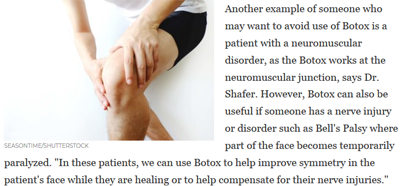
Unsure of when—or if—to go under the needle? Top skin experts weigh in on the dos and don’ts of this popular anti-wrinkle treatment.
Ready for Botox?

Olena-Yakobchuk/Shutterstock
To get , or not to get Botox—that seems to be the question on the minds of women (and men) spanning from ages 25 to 65. Hailed as the most effective wrinkle treatment on the market today, Botox, or botulinum toxin, is just one of many FDA-approved brands that do the very same thing. “Botox is a brand name just like Kleenex or Xerox, which people associate with the actual product and use as a general term,” says David Shafer, MD, board-certified plastic surgeon and RealSelf contributor. “All of the products work very similarly, but differ in their molecular configurations and manufacturing.” Dysport® and Xeomin are two other brand names for the injectable anti-wrinkle treatment, which seems to be skewing towards a younger audience by the minute. In fact, according to the American Society of Plastic Surgeons, more than 7 million Botox procedures were performed in 2016 alone, and over 126,500 of them were on adults under the age of 29. So if age isn’t always a determinable factor to help in your decision to get Botox, what is? We turned to the nation’s top skin-care professionals for signs that you may or may not be ready for Botox.
You’re ready if: you start noticing deep-set wrinkles and skin thinning

Africa-Studio/Shutterstock
For most people, this happens in their late 30s or early 40s, and can be determined when fine lines start appearing in unwanted places. “Botox freshens up the face and temporarily reduces the appearance of lines, like glabella ‘elevens’ (the parallel furrow between your brow). You can start once you notice the angry look or the fine lines appearing,” says Tsippora Shainhouse, MD, Beverly Hills-based dermatologist. “It’s best to do the procedure around the time these lines begin to appear, however, because once you have deep-set wrinkles and your skin is significantly thinner (50+ years), neurotoxins alone are not sufficient.”
You’re not ready if: you have a heavy brow

Sruilk/Shutterstock
Especially older patients who have and a great deal of wrinkling in their forehead should be careful about using Botox. “These older patients often need their brows lifted in order to help assist their eyelid to open properly, so when Botox is used, their lids get heavy sometimes to the point where their eyelids close involuntarily,” says Dr. Brandow. “Some patients who are treated with Botox around their eyes will often times get a cheeky smile where their cheeks get too puffy and come up too much giving them a weird look to their face.” This is one of the reasons why it is so important to be carefully examined by a licensed professional before using Botox in any form.
You’re ready if: you see deep wrinkles when you make facial expressions

Goodluz/Shutterstock
Known as dynamic rhytids, these wrinkles disappear when you’re no longer making any facial expressions. One you have static rhytids, or wrinkles that remain on your face once you are no longer making facial expressions, it can be difficult to treat the fine lines. “In these cases, Botox may not be sufficient to completely erase the wrinkles” says Dr. Shainhouse. “However, Botox can still reduce the depth of the static wrinkles and prevent them from becoming deeper and more ‘etched in’, by minimizing muscle contraction in the treated area(s).”


